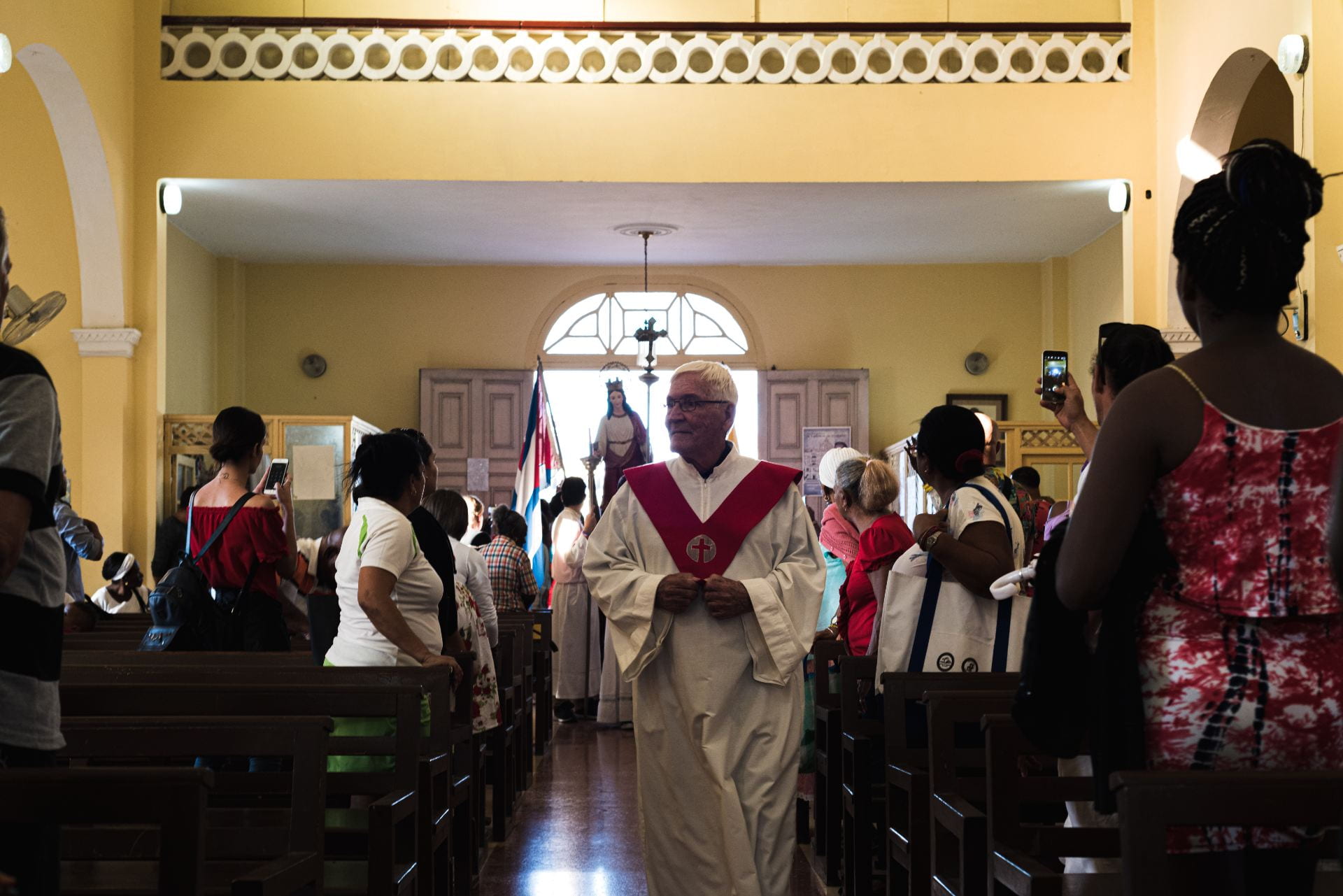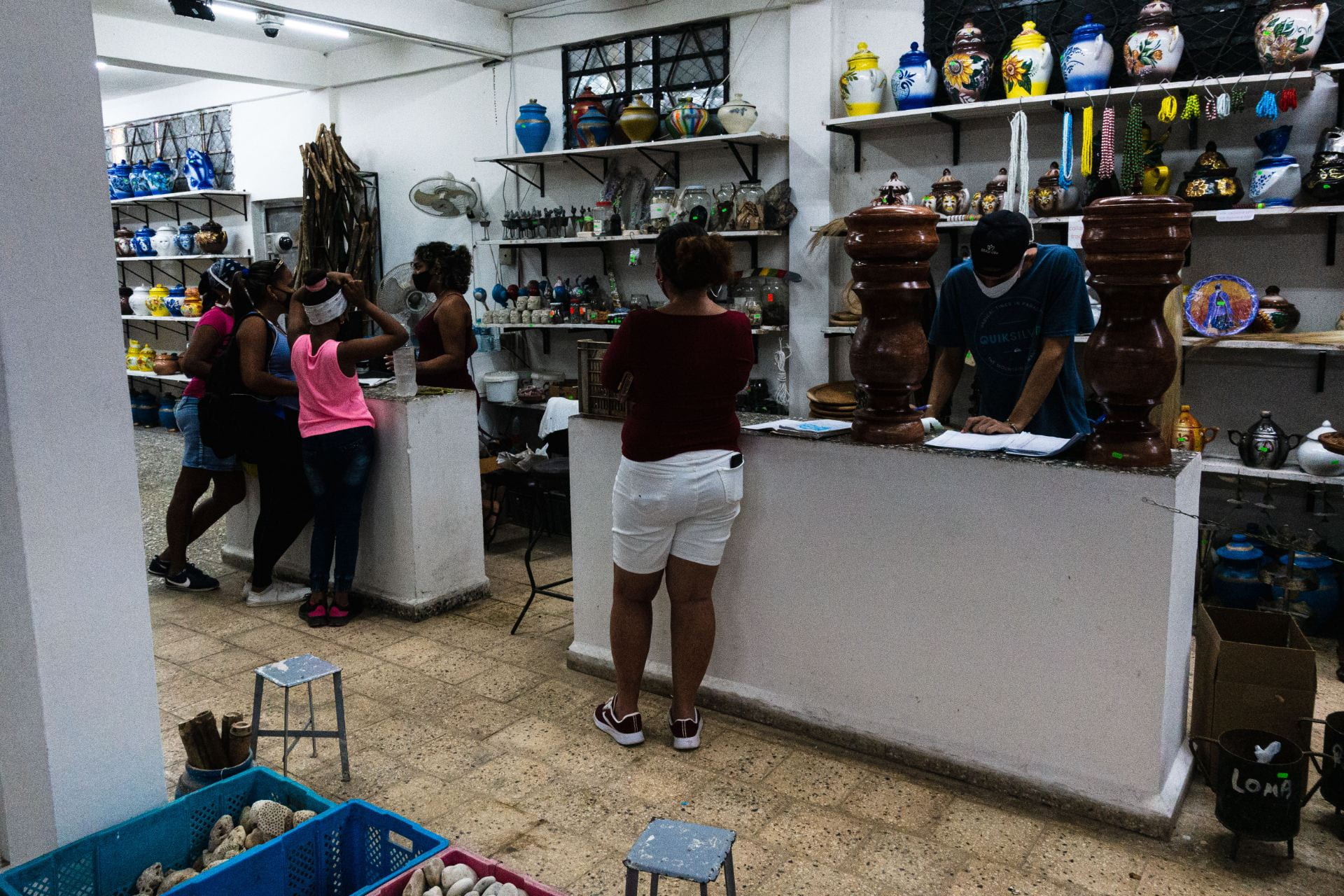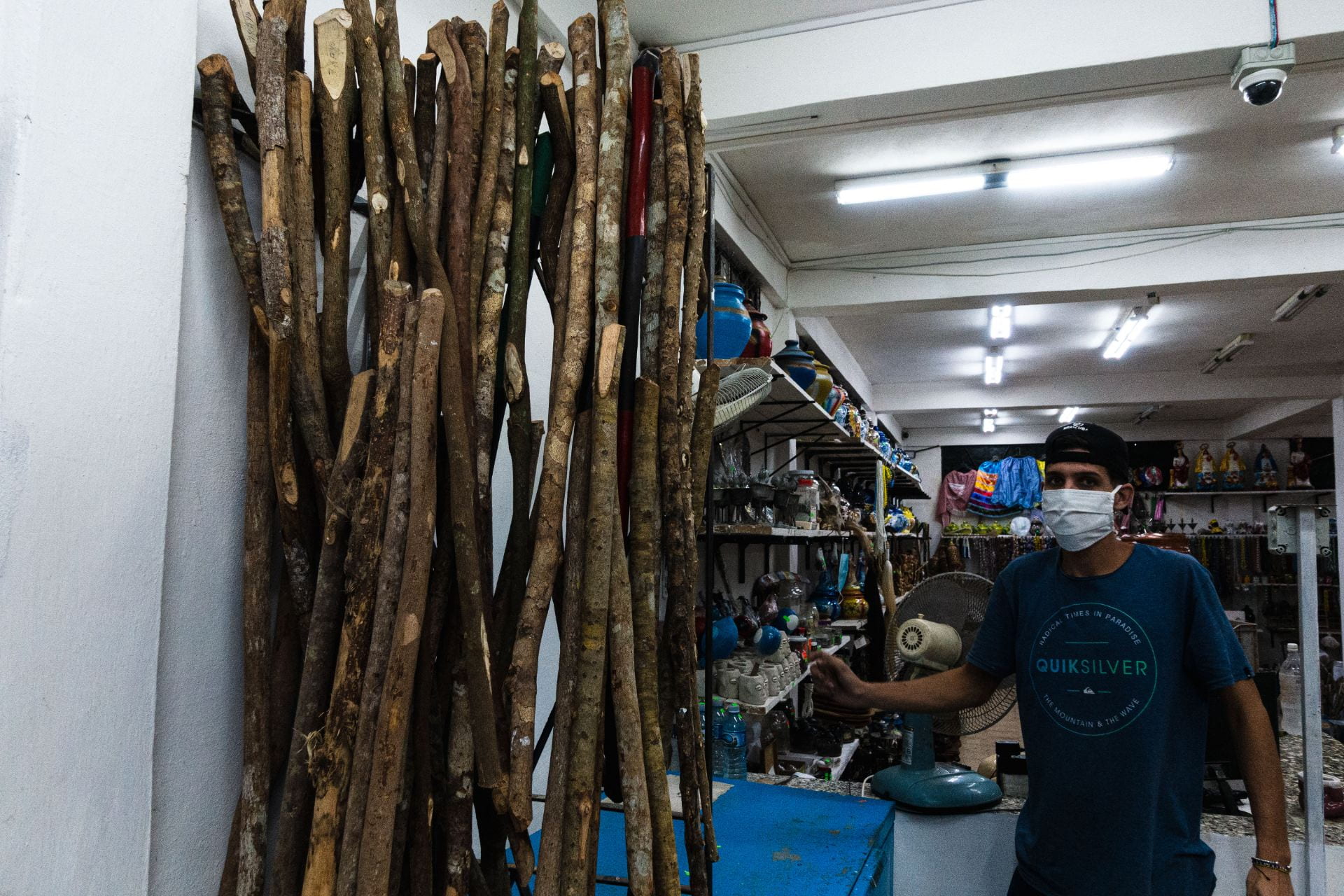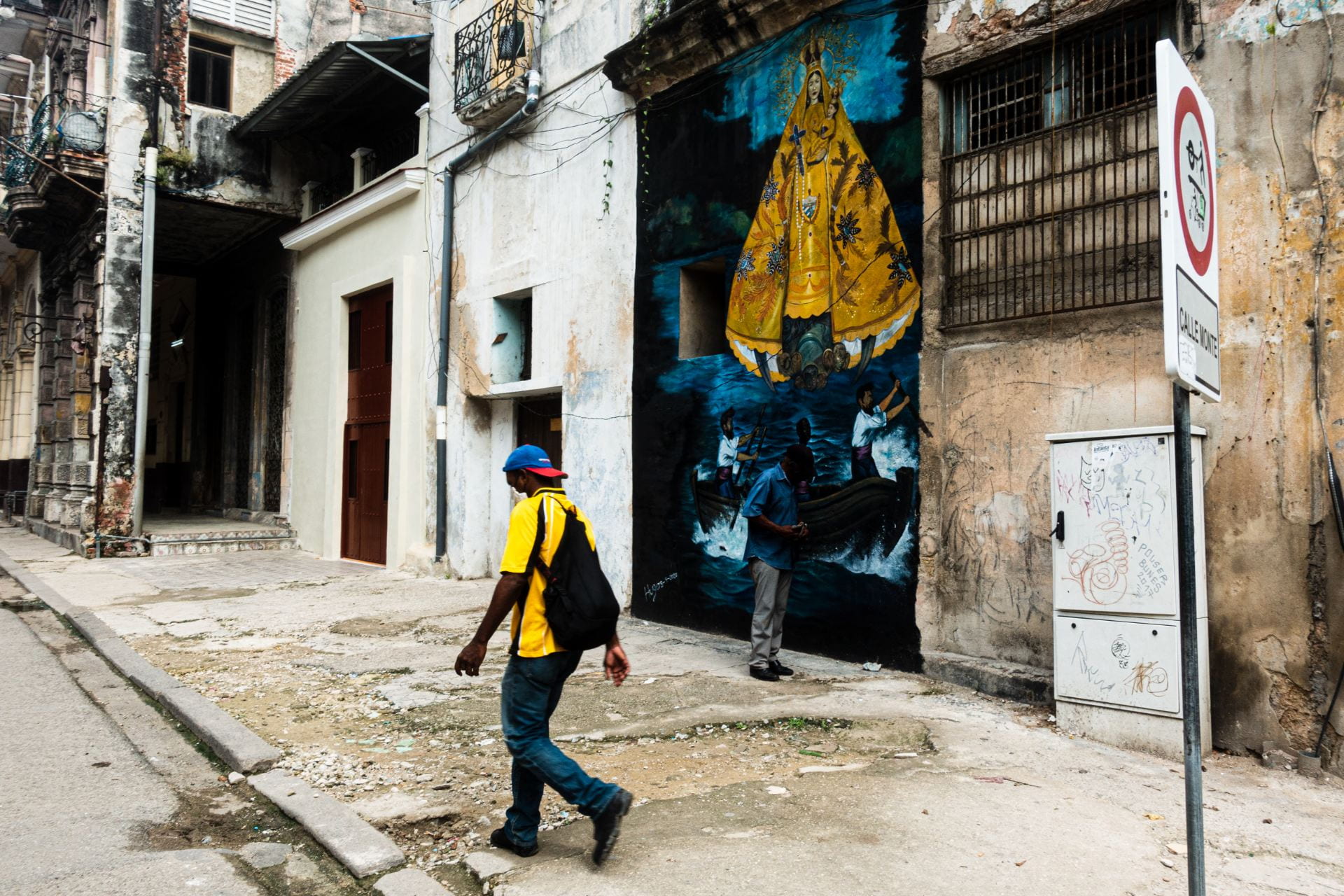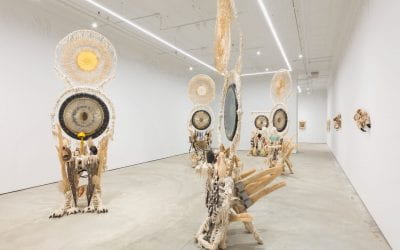Religion: A Cultural Trait in Cuba
Photos by David Estrada
With the arrival of the year 2020 and the accompanying Covid-19 pandemic, we could not imagine how much everything was going to change. What seemed to be daily routine was no longer. Religion, which continues to be a significant cultural characteristic in Cuba—as in all of Latin America—was not exempt from the crisis. Religious practice were forced to adapt because of necessary social distancing to put a brake on this lethal and highly contagious disease, which is still racking up startling numbers of illnesses and deaths a year later.
In spite of what many people think, how Cuba is perceived in the “collective imagination,” Cuba is a secular state in which religious freedom is guaranteed both by the Constitution and by immense and diverse religious structures that act independently of the government. Most Cubans on the island are religious believers with a marked “religious syncretism,” which is nothing more than a blend of elements from different religions.
To control the coronavirus, religious institutions in Cuba consider it necessary to modify their activities. Sunday Christian mass was suspended. Rituals and ceremonies were reduced to a handful of participants and relocated to spaces with strict sanitary protocols. Tourist visits to popular historic-religious sites such as the Convent Complex and the Church of San Francisco de Asís in Havana, the catacombs of the Church of Nuestra Señora de la Merced in Camagüey or the Catedral Santísimo Sacramento in Bayamo. Simple customs among religious people, such as the embrace of peace or a gift of an object of adoration were highly restricted because they are high-risk activities for transmitting the disease.
The closure of reigious institutions and the economic crisis sparked by the pandemic because of the limitation on productive economic activities implies a budget deficit, above all in local congregations because of the drop in revenues. This socio-economic situation had a negative impact on church employees and in the sales of religious articles by independent (‘cuentapropista”) workers who have found their costs spiraling because of pandemic-induced increases in the costs of raw materials.
Traditional historic events were canceled. The much anticipated procession of the Virgen de la Caridad del Cobre (Our Lady of Charity, Oshún in the Yoruba religion), the patroness of Cuba, could not be celebrated September 8 as it has been over countless years with a pilgrimage to the sanctuary in the town of El Cobre, Santiago de Cuba. A devotional mass was still held in the sanctuary and in other nearby churches to reduce crowding. The December 17 pilgrimage to the sanctuary of San Lázaro (Babalú Ayé) in El Rincón, twelve miles from Havana, took place with strict crowd control and preventative health measures.
There were many other drastic measures, but there was also reinvention. Religion opted for humanitarian aid and the adaptation of its services to the Internet to be able to continue by the side of the most needy and vulnerable. They loaned their churches as shelters and provided volunteers to take care of the sick.

Shy church gardener of Regla town explains that the place is closed due to Covid but they keep helping people
In Cuba, like in the rest of the continent, communities of faith carried out campaigns to collect food for public dining halls, medicine and medical equipment for the sick, and their achievements garnered headlines everywhere. Liturgies and other religious celebrations gathered more force through the Internet. Live transmissions, multimedia convocations of collective devotion and spiritual attention through chat have been some of the most effective ways to promote messages of optimism.
And in the face of the fragility of the world, spirituality is an opportune response. Certainly some doubted their faith because of the fear and uncertainty that are understandable in times like this. Among the most faithful, the prayers increased: the healthy asked not be sickened and the sick asked to be cured. Each prayer also left room for pity for those who are grieving, thanks to medical workers and devotion to God with the hopes that this pandemic will finally be over.
Religión: Un rasgo cultural en Cuba
Por Lizbeth Santos Venegas
Fotos por David Estrada
Cuando llegó el 2020 y con él la pandemia de Covid-19, no imaginamos cuánto iba a cambiar todo. Lo que parecía cotidiano dejó de serlo. La religión, que no ha dejado de ser un rasgo cultural significativo en Cuba—como en toda Latinoamérica –, no estuvo exenta de la crisis. Las prácticas religiosas se vieron forzadas a reajustarse por el necesario distanciamiento social para frenar la enfermedad altamente contagiosa y letal, que en este lado del mundo sigue sumando cifras descomunales de muertos y enfermos un año después.
A pesar de lo que el imaginario colectivo puede inducir, Cuba es un Estado laico donde la libertad religiosa queda amparada tanto por la Constitución como por la inmensa y diversa estructura religiosa que actúa con independencia del Gobierno. La comunidad devota en la Isla alcanza a la mayoría de los cubanos con un marcado ¨sincretismo religioso¨ que no es más que la mezcla de elementos de varias religiones.
Para controlar el contagio del nuevo coronavirus entre los cubanos, las instituciones religiosas consideraron necesarios condicionar sus actividades. Las misas cristianas de los domingos fueron suspendidas. Los rituales y ceremonias, reducidos a escasos participantes y removidos a otros espacios con estrictos protocolos sanitarios. Quedaron suspendidas visitas turísticas a lugares histórico-religiosos de gran acogida como el Conjunto de Convento e Iglesia de San Francisco de Asís en La Habana, las catacumbas de la Iglesia de Nuestra Señora de la Merced en Camagüey o la Catedral Santísimo Sacramento de Bayamo. Costumbres simples entre los devotos, como un saludo cercano u obsequiar un objeto de adoración, quedaron limitados por los altos riesgos de propagación de la enfermedad.
El cierre de las instituciones religiosas y la crisis económica que abrió la pandemia por la limitación de las actividades productivas implicaron un déficit presupuestario, sobre todo en las congregaciones locales, por la disminución de las recaudaciones. Esta situación socioeconómica también incidió negativamente en el salario de los empleados de las iglesias y en las ventas de los trabajadores por cuenta propia que comercializan artículos religiosos, a quienes se les ha encarecido además la obtención de la materia prima.
Hubo eventos de tradición histórica cancelados. La esperada procesión de la Virgen de la Caridad del Cobre (Oshún en la religión Yoruba), Patrona de Cuba, no pudo celebrarse este 8 de septiembre de igual manera que otros años: la tradicional peregrinación hacia el Santuario en el poblado El Cobre, Santiago de Cuba, fue suspendida, aunque se mantuvo la misa de devoción en esta y otras iglesias cercanas para evitar aglomeraciones. El peregrinaje del 17 de diciembre hacia el Santuario a San Lázaro (Babalú Ayé) en El Rincón, a 20km de La Habana, pudo realizarse sin la usual masividad de personas y con la vigilancia y control de las medidas preventivas.
Hubo muchas otras medidas insólitas, pero también hubo reinvención. El credo abogó por la ayuda humanitaria y la adaptación de sus servicios a modalidades digitales para continuar al lado de los más necesitados y vulnerables. Prestaron sus templos como refugios y muchos creyentes se ofrecieron voluntarios para cuidar de los enfermos.

Shy church gardener of Regla town explains that the place is closed due to Covid but they keep helping people
En Cuba, como por todo el continente, las comunidades de fe desarrollaron campañas para recolectar alimentos para comedores sociales, medicinas y equipos de asistencia médica para enfermos; y sus logros acapararon titulares en todo el mundo. Liturgias y otras dinámicas religiosas entraron con mayor fuerza vía Internet. Transmisiones en vivo, convocatorias multimediales de devoción colectiva y la atención espiritual en chats han sido las mejores formas para promover mensajes de optimismo entre todos.
Y ante la fragilidad del mundo, la espiritualidad es una respuesta oportuna. Ciertamente algunos dudaron de su fe porque el miedo y la incertidumbre son comprensibles en tiempos difíciles como este. Entre los más fieles, las plegarias aumentan: los sanos imploran no enfermarse y los enfermos piden curarse. Cada rezo guarda también un espacio para la piedad por las personas en duelo, el agradecimiento al personal médico y la devoción a su Dios con la esperanza de que esta pandemia acabe por fin.
Lizbeth Santos Venegas is the Community manager for the Cuban News Agency. She has a degree in Communications from the University of Havana.
David Estrada is a Cuban photographer. His photos were selected for the digital photo exhibition, “Documenting the Impact of Covid-19 through Photography: Collective Isolation in Latin America,” curated in collaboration with ReVista and the Art, Culture, and Film program at Harvard’s David Rockefeller Center for Latin American Studies (DRCLAS.)
Lizbeth Santos Venegas es Community manager (gestor de redes sociales) para la Agencia Cubana de Noticias. Es graduada en comunicación social de la Universidad de la Habana.
David Estrada es fotográfo cubano. Su obra fue seleccionada para la exposición, “Documentando el impacto de Covid-19 a través de la fotografía: Aislamiento colectivo en Latinoamérica”, auspiciado por ReVista y el Art, Culture, and Film program del David Rockefeller Center for Latin American Studies (DRCLAS) de Harvard.
Related Articles
Brazil’s Vaccinated Democracy
In March 2021, former Brazilian president Luiz Inácio Lula da Silva, a current presidential candidate, posed a pointed question in a speech lambasting President Jair Bolsonaro’s Covid-19 response. “Where is our beloved Zé Gotinha?” Zé Gotinha is not a respected public health expert or crisis manager
Broken Land: Climate Change and Migration in Guatemala
Broken LandClimate Change and Migration in Guatemala Santos Istazuy Pérez (right) sits in meditation during a group hike and workshop at a lush farm along with fellow Guatemalans and like-minded people from around the world including Germany and Uruguay. Photo by...
The Gift of Art
My dear friend, Colombian pioneer performance artist, Maria Evelia Marmolejo, (Cali, Colombia, 1958) whom I met during the research for the exhibition Radical Women: Latin…





